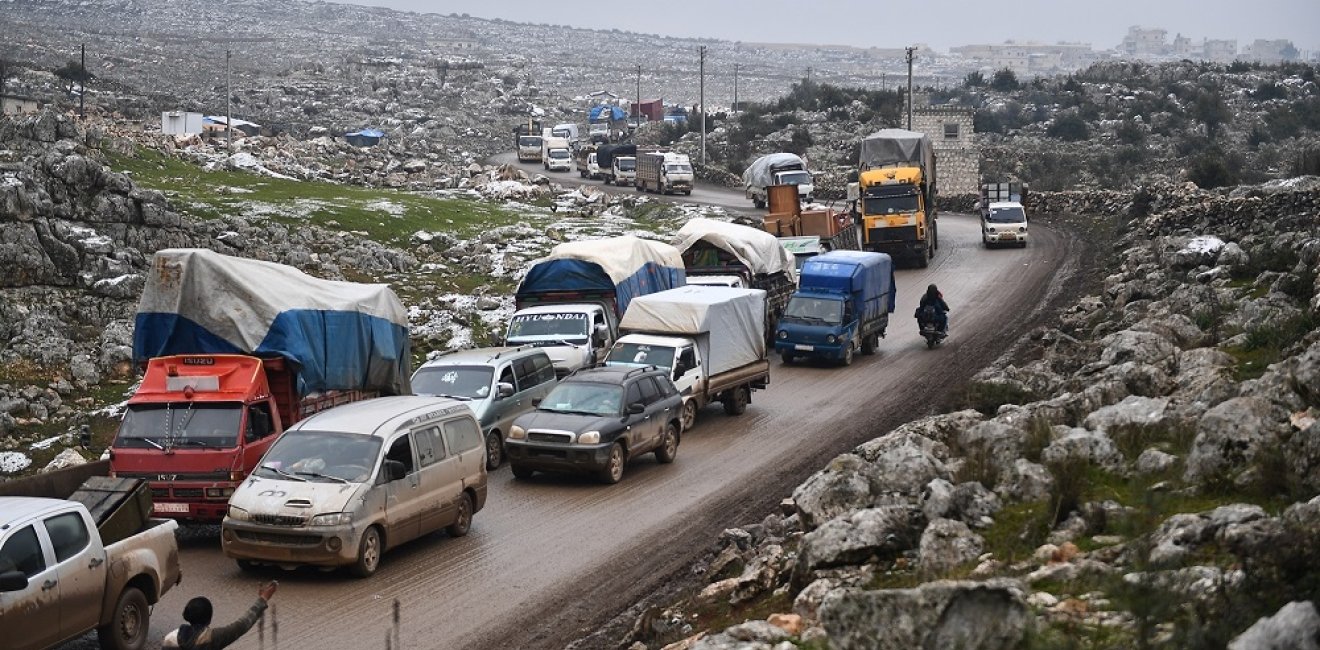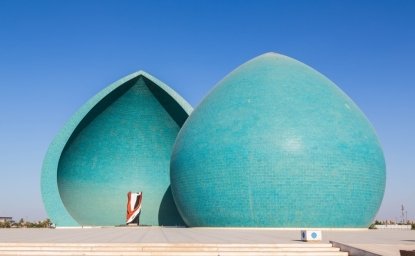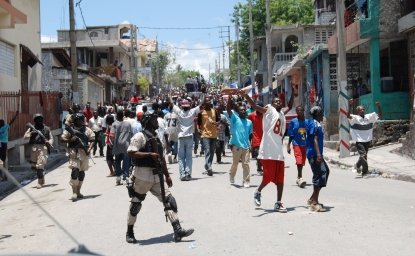Nearly one million people are on the run in Idlib, fleeing the advances of the Russian and Iranian-backed Syrian regime. Over half of the population of Syria has already been displaced, either internally as IDPs or externally as refugees. Yet the assault on Idlib since December has led to what may be the single biggest displacement of people since the conflict began in 2011. Turkey has numerous outposts in Idlib, a region that is the last redoubt of the armed opposition in Syria including jihadist groups such as Hayat Tahrir al-Sham. Last week, over 30 Turkish soldiers were killed by Russian and Syrian regime forces, prompting Turkish President Recep Tayyip Erdogan to request that NATO invoke its mutual defense pact.
On Tuesday, a US-UN delegation visited two Turkish-Syrian border crossings that are a lifeline for the besieged population. Envoy James Jeffrey, US Ambassador David Satterfield, and UN Ambassador Kelly Craft announced $108 million in additional humanitarian assistance. This is a welcome step and the aid is desperately needed. It is also unprecedented and appears to be the first such visit for American diplomats to Northwest Syria, an area where Russia and Turkey vie for influence. By contrast, US officials have made numerous visits to the region East of the Euphrates river, where the Syrian Democratic Forces (SDF) control about one-third of Syria.
Special Envoy Jeffrey said that the US is willing to provide Turkey with ammunition and US Ambassador Satterfield said that Washington was also examining Turkey’s request for air defense systems.
If handled properly, the crisis in Idlib offers the chance to reduce tensions between Turkey and the Syrian Democratic Forces (SDF) – and potentially even limited cooperation. Or, it could entrench their hostilities further. Turkey deserves credit for hosting some 3.6 million Syrian refugees. And they deserve our sympathy for the soldiers who were killed last week. However, this does not mean we should offer a blanket endorsement for Turkish actions in Idlib. One reason the US cannot come quickly to the rescue is because last October, Erdogan himself ordered US troops to withdraw from northern Syria so that he could attack the SDF. In their phone call on October 6, President Trump caved to Erdogan’s demands, and US troops began their withdrawal, as Turkish troops surged across the border. The withdrawal of US forces was later halted. However, instead of being just 85 miles away from Idlib, as they were prior to the October 6 phone call, US forces are now some 500 miles to the east.
If handled properly, the crisis in Idlib offers the chance to reduce tensions between Turkey and the Syrian Democratic Forces (SDF) – and potentially even limited cooperation. Or, it could entrench their hostilities further.
The problem with providing ammunition to Turkey is the difficulty in ensuring that it doesn’t wind up in the hands of the proxy forces that are working alongside Turkey in the Syrian National Army (SNA). Some of those proxy forces stand accused of war crimes and other serious human rights abuses.
In October, the unification of the armed opposition groups was announced from the Turkish city of Şanlıurfa. Until now, the headquarters of the Syrian Interim Government as well as the headquarters of the armed groups have been based in Turkey.
According to an October 2019 report by the Ankara-based Foundation for Political, Economic, and Social Research (SETA) “Uniting the Syrian Opposition”, Turkey is the “sole backer” of what is now called the “Syrian National Army” (SNA). The SNA currently consists of 41 different factions. The SETA report breaks down who the factions in the Turkish-backed SNA have they fought against as follows:
The Syrian National Army consists of 41 factions. Who have they fought against in the past?
- 31 factions fought against the YPG/SDF
- 30 factions fought against the Assad regime
- 27 fought against the Islamic State
- 11 factions against Hayat Tahrir al-Sham or the Al-Nusra front
In other words, according to SETA, more of the factions fought against the SDF/YPG than any other group. Furthermore, the report stated that the declaration of the unification “comes ahead of the possible Turkish operation against the YPG/SDF.”
Given that the Turkish-backed SNA has clearly stated their intention to launch another operation against the SDF, how will the US ensure that the ammunition provided to Turkey is not used against the SDF?
Instead of offering ammunition, the United States could offer something much more meaningful, which may save lives, and which they can’t easily get from other suppliers. The US could offer to assist both Turkey and the SDF with establishing a vetting process to help differentiate between innocent civilians and those who are affiliated with Islamist extremist groups, which have made Idlib their stronghold. Some of these groups include Hayat Tahrir al-Sham (HTS) an alliance of jihadist groups, the National Liberation Front (Turkish-backed rebel alliance), Hurras al-Din, an offshoot of HTS that supports Al Qaeda, and the Turkistan Islamic Party (TIP), which is dominated by Chinese Uighur jihadists.
People in Idlib have fled both north towards Turkey (becoming refugees) and east towards SDF-controlled territory (becoming IDPs). Both Turkey and the SDF would benefit from humanitarian assistance to support the IDPs and refugees, but also with US assistance in establishing a proper vetting process.
Both Turkey and the SDF would benefit from humanitarian assistance to support the IDPs and refugees, but also with US assistance in establishing a proper vetting process.
The Self Administration of North East Syria and the SDF have a vetting process already in place for people fleeing Idlib. Many of them enter SDF territory through Manbij. Two entire factions that were previously part of the Free Syrian Army (FSA) armed opposition are now aligned with the SDF: the Army of Revolutionaries and Northern Democratic Brigade. Some residents of Idlib have also joined the SDF as individuals.
In my own survey of the SDF, which I carried out in all six provinces of North and East Syria under SDF control, I discovered that numerous Syrians had joined the SDF although they did not live in SDF-controlled territory. Some had joined from regime-controlled territory such as Damascus or Homs. Others had joined from Idlib. For example, one person who took my survey was an Arab male who was born in Idlib. He joined the SDF in 2017 while residing in Idlib, along with his father who also joined the SDF. He later went on to fight with the SDF in Deir Ezzor, where he was a leader of a unit of 10 soldiers.
This example illustrates that the SDF has some appeal even among people who do not live in areas they control. Secondly, it highlights that the SDF already has a process for admitting people from Idlib. The presence of Islamic State sleeper cells in Northeast Syria has made the Self Administration understandably cautious about admitting people to their territory from Idlib, given the large number of armed extremists based in Idlib. However, it does happen and some individuals from Idlib may even be promoted within the ranks of the SDF. US assistance could help expedite and improve the vetting process.
...some individuals from Idlib may even be promoted within the ranks of the SDF. US assistance could help expedite and improve the vetting process.
In the fog of war over Idlib, a few simple points may have been obscured. Despite the recent Turkish incursions into northern Syria and escalation of tensions, both Turkey and the Syrian Democratic Forces (SDF) are US partners. They both need assistance with supporting IDPs and refugees. Both would benefit from US support to improve their vetting processes as the number of people fleeing Idlib increases every day. How we respond to the current crisis in Idlib could either reduce tensions between Turkey and the SDF, or enflame them further.
The views expressed in this article are those of the author and do not reflect an official position of the Wilson Center.
Author

Research Professor of International Affairs and Acting Director of the Foreign Area Officers Program, George Washington University

Middle East Program
The Wilson Center’s Middle East Program serves as a crucial resource for the policymaking community and beyond, providing analyses and research that helps inform US foreign policymaking, stimulates public debate, and expands knowledge about issues in the wider Middle East and North Africa (MENA) region. Read more





